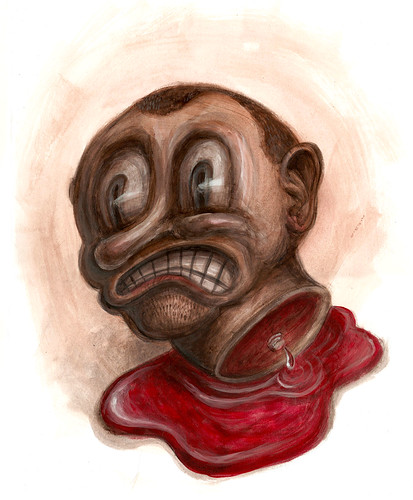Periodic Table Reference:
Color Charts & References:

An element is a chemically pure substance consisting of a single type of atom, such as
oxygen, lead, or uranium. In 1869, the elements were organized according to their
chemical properties and atomic number by Dmitri Mendeleev. This chart is called The
Periodic Table, and has, with refinements, been in use ever since. For this assignment, we
will create an illustrated Periodic Table. The illustration will be 12”x12”.
OBJECTIVES
To use research and ideation techniques to develop narrative from a non-narrative point
of departure; to build upon the compositional, referenced, and painting skills from Project
1; to use a near-complementary color scheme in a painting; to balance multiple formal
demands with the need to create a striking image.
PROCEDURE
Chose a chemical element, and sign up for it on the posted Periodic Table. Only one
person may pick a given element.
Research your element, making note of at least ten distinct facts about it. These may be
from the history or folklore relating to the element, interesting physical properties, or uses
and applications. To this list of ten you may add any personal associations you may have
with this substance. From this list, develop a mind map, spinning out associations from
these facts, and then building on those associations. When you have developed a rich
map of associations, look for connections between concepts from different branches of
the map. Make note on the map of interesting visual and narrative ideas that come out of
these connections.
Ideally, you are seeking two things: a basic narrative to depict in your illustration, and at
least one other thematic reference to the element. Take antimony as an example. This
metalloid substance, which I’d never heard of until seeking out an obscure element to use
as an example, doesn’t seem very promising, at first. It’s shiny, in a chintzy sort of way, and
has a number of industrial uses: it’s used in plumbing, and matches, and flame-proofing
compounds. But then I find out that it was used make kohl, the dark eye makeup favored
throughout the Ancient World. Now, all sorts of narrative possibilities open up: Cleopatra
being made-up before meeting Caesar; Salome dancing for the head of John the Baptist,
even Johnny Depp dressing up as Jack Sparrow. Pretty much any scene from history or
myth that involved a man or woman wearing eye make-up is fair game. Drawing
connections between Cleopatra’s Egypt and antimony’s use in matches and
flame-proofing leads me to Sekhmet, the Goddess of Fire. So, Cleopatra being made-up
with kohl before meeting Caesar is my main narrative for my illustration, and images of
Sekhmet (as well as some compositionally prominent braziers) addresses my secondary
thematic reference to antimony.
In addition to the narrative content and at least one secondary reference, the illustration should include the atomic number of the element being depicted (in the case of antimony, this is 51).
SKETCHING: Develop25 thumbnail sketches of your idea. Each thumbnail should be a
different compositional approach to the image. Select the three best compositions and
draw them larger (around 4”x4’) and neater, so that you can present them to the class.
PHOTO-REFERENCE: Collect the friends and props necessary to shoot good references
for your illustration. As with Tableau Vivant, use the photo-shoot as an opportunity to
explore and refine your composition. Bring at least ten good shots to present to the class.
Additionally, collect any other photo-references you will need for your image.
DRAWING: Based on the feedback you receive in class on your photographed
compositions, develop your drawing at the size of the final illustration. Determine each
figure on separate layers of tracing paper, as well as the background, and any major props.
Manipulate the layers of tracing paper around to tweak your drawing. When you are
satisfied with the composition, transfer it to illustration board.
PAINTING: This image will be rendered in a near-complementary color scheme. Using a
color wheel, determine the palette of your piece. You may use only these two colors,
black, and white. Spend some time in your sketchbook making some color swatches with
these paints: the 2 near-complementary colors, at least three neutral tones created by
mixing them in different proportions, and then tints (the color mixed with white), shades
(the color mixed with black) and tones (the color mixed with grey) of all 5 colors. This is
a very limited palette, but it can be very effective when considered carefully, and used
strategically.
PRESENTATION: When the painting is finished, flap the illustration board with a sheet of
tracing paper and a sheet of cover stock.
2/15
Project 1: Tableau Vivant critiqued.
Project 2: Periodic Table element chosen.
2/17
Project 2: Work on Periodic Table thumbnails
2/22
Project 2: Periodic Table thumbnails and written research due.
2/24
Project 2: Periodic Table research and photos due .
Illustrator Research due.
In Class: begin drawing.
3/1
Project 2: In Class work on Periodic Table drawing
3/3
Project 2: Periodic Table drawing due
3/8
Project 2: Periodic Table critiqued.
3/10
Mid-Term.
Project 3: Invisible Cities assigned.
In Class: Exercise 5: Color Textures
3/14
Spring Break.
3/17
Spring Break.
3/22
Project 2: Periodic Table due.
In Class: Work on Project 3 thumbnails



